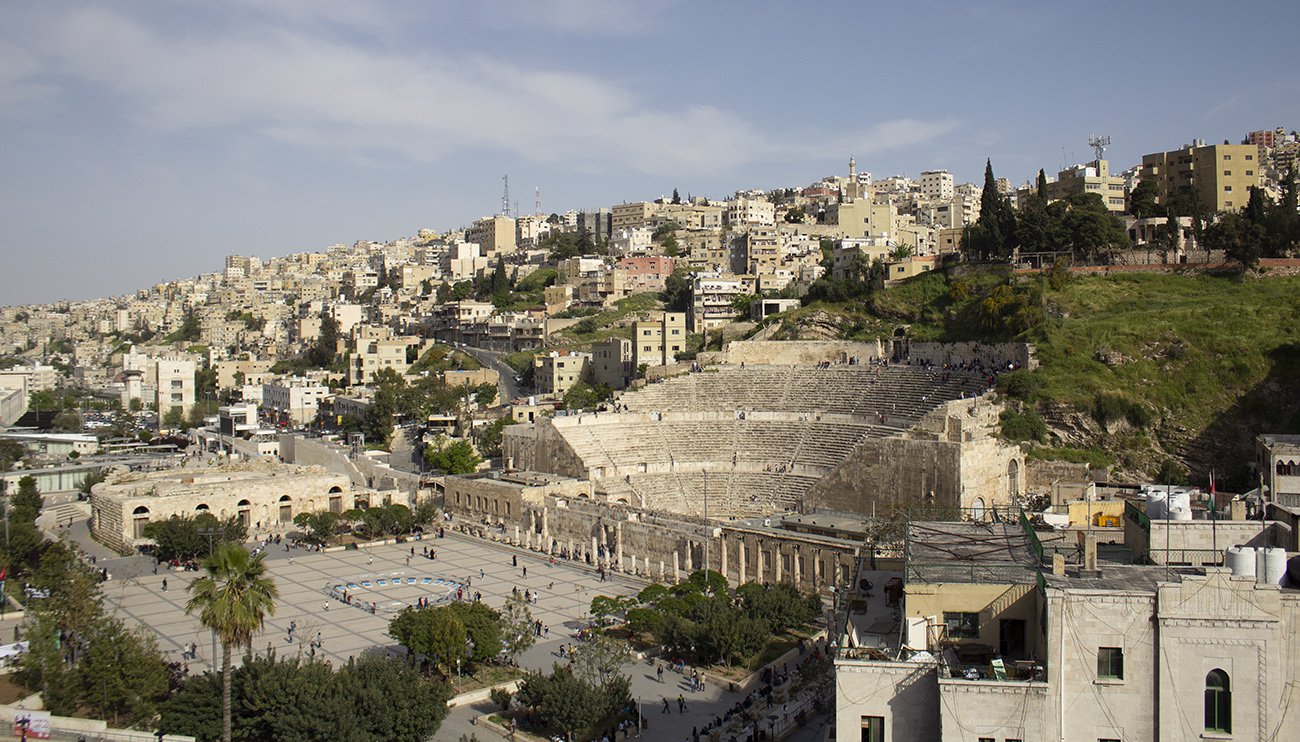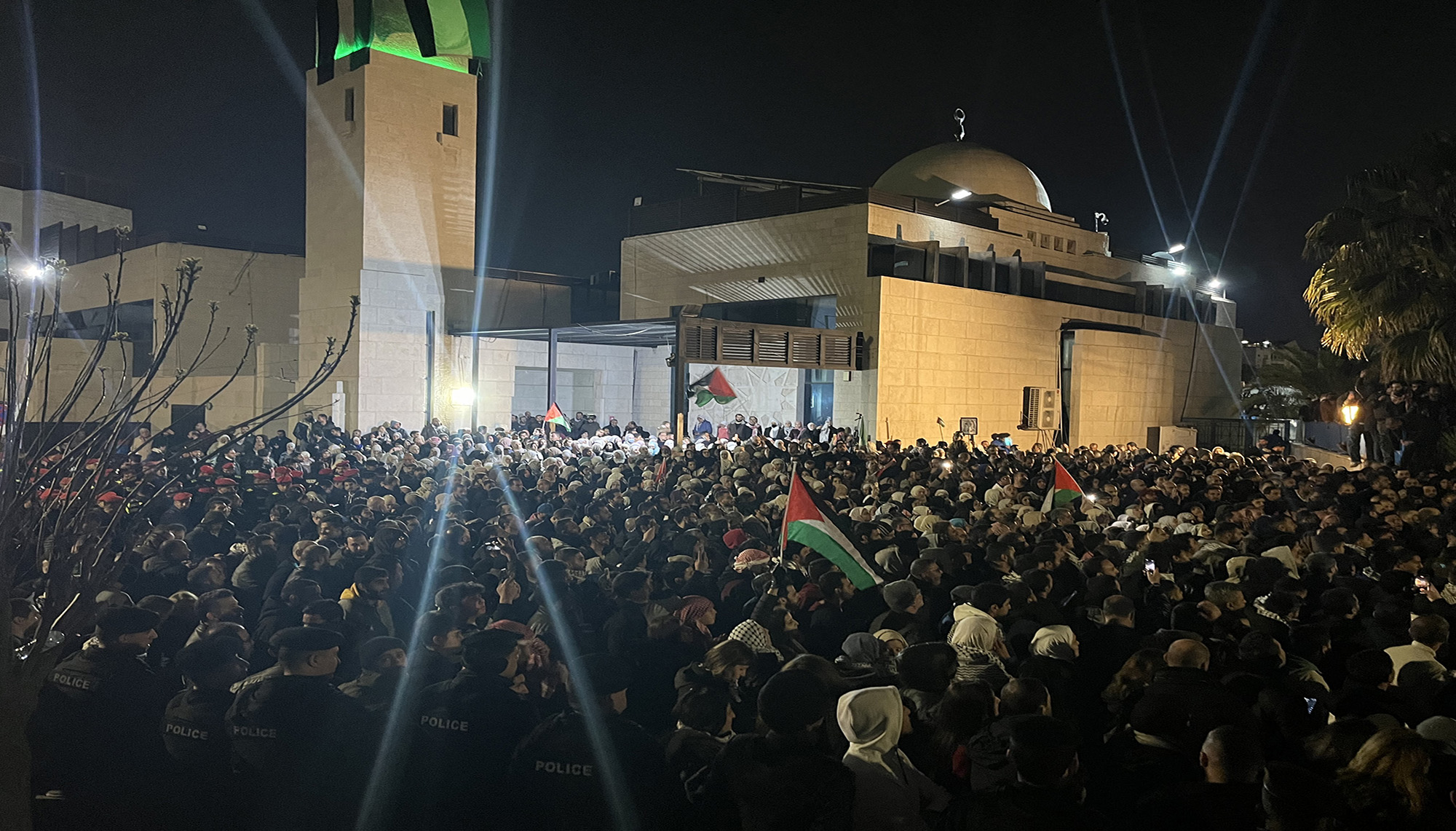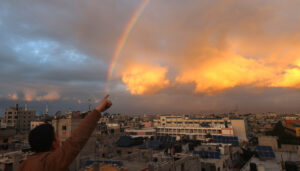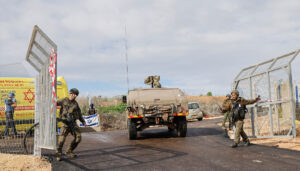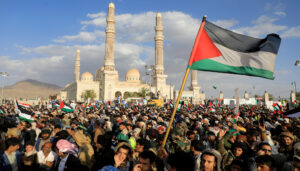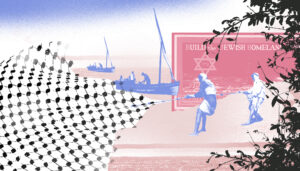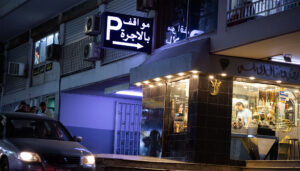In a paper presented at a conference about Amman in 1995, the late architect Jafar Touqan described the urban expansions that occurred in Amman beginning in the 1960s as “surprise convulsions.”
Touqan, who began working in architectural design in Amman at the start of the 1960s, saw the city as it grew, fleeing its center by jarring leaps in urbanization.
For several decades of contemporary Amman’s existence, this center constituted the whole of Amman. Even when the city grew, the center retained its distinguishing feature as a public sphere in which all of the capital’s residents would gather, as well as all of the arrivals from different areas of the country. Here, there were relatively splendid hotels and Faisal square, in which celebrations and public shows were held. Here was Al-Husseini mosque, in which the king would lead Friday prayer amid a throng of people. Here was the Roman Theater and its various events such as wrestling and boxing matches, in which Fairuz sang, and where an ice-skating show was held!
Similarly, the national celebration of the victory of the Algerian revolution was also held there.
And in this center, markets were established and were frequented by all classes of society. Until recently, for example, the gold market in Al-Shabsough area still attracted the brides of Amman. Likewise, the rest of the markets that later took the name “popular markets” were previously just considered central markets.
It was also here that the first market following the emergence of the poverty phenomenon in Amman was established. It is called the “Yamaniya Market,” and it started as a marketplace for secondhand European clothes that piqued people’s curiosity and their imaginations, and continued to the present with a short interruption of two years. The interruption was due to the new market owner’s attempt to transform it into a modern marketplace like the rest of the nearby markets. He put a large sign up bearing a new name. Longtime workers remember however, that customers refused the market name change via a popular protest that was neither organized nor officially announced, and that manifested as a boycott of the shops in the new market.
This hindered the attempt to replace the market’s content, which soon recovered its characteristics, and these remain essentially the same to this day.
Slowly, but notably, Amman began to flee from its center, which took shape as the “bottom of the city.” This term, when referring to Amman, was a new terminology. The city was alienating itself from its center and exalting itself from it.
It is true that, from an early period, a number of markets were established in parts of central Amman with marginal (urban) activity: the Halal market was established to buy and sell livestock near Ras Al-Ain, then the Al-Haddada and Al-Samkara markets were established. A market for street vendors was set up, and recently became known as “Al-Jora,” as well as a market commonly called “Souq Al-Haramia,” in which the business of selling used commodities spread. However, the center of the city remained a generally active and popular place for different residents in the 1970s and for most of the 1980s.
In the “public mind” of Amman residents and Jordanians generally, the city was united to a great degree at that time.
It should be noted that at the start of the 1980s, journalist Fakhri Kawar wrote an article titled “East Amman and West Amman.” The title alone was guaranteed to provoke a storm of protest and intense debate about the matter, due to the strangeness of that characterization at the time.
According to the late novelist Abdelrahman Munif, who wrote in his book, “Story of a City: Amman in the 1940s”, the most beautiful and accurate description of Amman at that time, the marginalized people of Amman were a major and present part of the life of all social classes.
The Adaptability of the Marginalized
The preceding paragraphs are not a precise history of the center of Amman, but they are an attempt to pave the way for the subject of this article, namely the shifts in marginalization in Amman’s center during the last few years.
The press archive clarifies that at the end of the 1960s and the beginning of the 1970s, a broad debate revolved around the problem of Amman’s center, and especially the issue of public transportation and public and private modes of transportation.
As part of confronting the problem, the Raghadan Transportation Complex was established in 1974 and hosted many transportation routes, especially those that connect the center of the capital to the southern and eastern regions, including Zarqa and Al-Rasifa and their villages and camps.
I still maintain the detailed written description that I wrote in 1997 about socio-economic life on the popular level in the Amman center area, specifically in the area extending between the (old) Raghadan Tourist Complex and the “Saqif Al-Sail” area.
This was in the context of a scientific anthropological study that discussed the informal “marginalized” economy in that location.
At the time, life proceeded in this place 24 hours a day, especially in the space stretching between the Raghadan Tourist Complex and the Hashemite Plaza, arriving at the Al-Husseini Mosque.
Transportation service east to Zarqa was continuous and available non-stop, including medium size buses, and restaurants offered their services to customers perpetually as well.
During this period, arrivals from Iraq after the Gulf War (1991) and the years of siege that followed distinguished the public scene of central Amman. Since a large number of Egyptian migrant workers were living there, the Iraqi and Egyptian elements blended together. Naturally, the Iraqis in this place were not generally from affluent sections of the population, so they joined working-class Amman residents in settling their families in nearby areas and overlooking hills.
During field research that lasted nine months, I was able to survey the social components of this area. Since my research targeted the informal sector and especially street vendors in the area, I became acquainted with the degree of complexity of the internal organization of this popular market, which extends along the pavements and sidewalks of the streets.
The marginalized people of the city were greatly present in this space on all weekdays, especially on Friday, which forms the peak of their activity.
During that time, the whole area took shape and reshaped itself to assist the changes taking place. Every morning, the area witnessed the movement of hundreds of thousands of citizens, just as it saw their return in the evening. In response, the market sought to match their needs, and this effort included the formal and informal sectors. Thus, as required services and shops were set up, vegetable stands became numerous at the last spots before people climbed onto buses and taxis. That way, customers didn’t have to carry their purchases for long distances.
In the westernmost part of the area, at the end of “Saqif Al-Sail,” there is a relatively large plaza located next to the public street, which drops by two meters in some places. Called “Al-Jora,” it is the biggest market for street vendors.
At the start of the 1980s, the vendors were ordered to leave the area due to the need to build a commercial building there. Another space was allocated for them, located exactly at the east of the Al-Mahatta bridge, and a building was erected there. It was divided into “numbers,” and the space of each was six square meters. These were distributed to the owners of the street vendor stands expelled from “Al-Jora.”
And with this, one of the first sites of marginalization to the east was established, and would expand later.
However, “Al-Jora” remained empty, and the construction of the commercial building did not begin until 2018, 45 years since the evacuation of the original street vendors. During that time, other marginalized activities were undertaken in “Al-Jora,” especially the business of selling secondhand goods. It was also occasionally used as a taxi parking lot, and in some years, vendors were permitted to set up stands there in exchange for fees.
The “Solidere” Project of Amman
From the beginning of the 2000s, the scene changed gradually but continuously. In 2003, the Greater Amman Municipality announced the launch of a project to rebuild the Raghadan Complex with a Japanese grant of eight million dinars. For this purpose, the place was sealed with metal fences, and the Municipality allocated three years to finish the project.
During that time, necessary facilities were built in the public space located near Al-Mahatta bridge in eastern central Amman to gather traffic temporarily, in anticipation of the Raghadan Complex’s completion.
Indeed, after three years, the completion of the project was announced. The metal fences were removed, and May 25, 2006 (Independence Day) was set as the inauguration of the project. But days before the set date, Omar Al-Ma’ani, the mayor of Amman at the time, announced the cancellation of the inauguration, and then the repeal of the idea of the Complex itself.
At the time, it was said that the large ultra-modern building would be rehabilitated for tourism purposes, and it was said literally that the center of the capital must not be just a corridor for road crossings and users of public transportation.
During those three years, many people readied themselves to respond to the return of the Complex. They constructed new buildings, merchants updated their existing shops, and the owners of licensed kiosks signed new contracts with the Municipality, which allocated places for them in the new building.
Thus, the relinquishment of the Raghadan Complex constituted a surprise to many, and entered everyone in a debate that resulted in instances of protest that included the formal and informal sectors.
Thereafter, the Municipality implemented a series of measures. Among these was permitting people to use the complex as a parking lot, and an attempt to redirect some traffic routes to it. This measure failed immediately, despite the pressures and police intervention, and the Municipality issued more than one promise to resolve the plight of market vendors.
Subsequently, the most prominent plan the Municipality announced had the objective of comprising Raghadan Complex in a massive project spread over 400 dunams. It was to be made up of the island located between Al-Mahatta street and Al-Jaish street, which begins at the historical Amman Municipality building (the public library now) and ends at Al-Mahatta bridge.
At first, the project was called “Solidere Amman,” named after the Solidere company, which built a similar project in the old center of Beirut. The old Municipality building was even going to be transformed into a hotel. The project also consisted of markets, cafes, wide pools, and expensive residential buildings.
On its website, the Municipality provided photo models of the project, and called it “Wadi Amman” (Amman Valley), which was to be part of a larger project carrying the name “Sahin Amman” (Plate of Amman). It included all of central Amman,which comprises most of the city’s roots. The Municipality did indeed undertake a wide appropriation of land, and demolished many facilities and terminated the licenses of many workshops and stores located within the area of the project.
Work on the project stopped once again, and then the whole framework of ideas that took the name “comprehensive Amman plan” collapsed. The department that formed the factory for all of those ideas (Urban Amman Institute) was terminated, and the activities of its famous director Jerry Post, who came from the Canadian BearingPoint company, were halted.
Modern Ruins
On the periphery of this modernization drama in central Amman, people with a vested interest in this place were not on the mind of the city planner nor on that of the executor of the plans.
People were, in reality, the last to know and the first to be injured. And these people include large swathes of the business sector and its various industries, since the area counts as a base for the food supplies business generally. Also within the area there is a concentration of the oldest central markets for vegetables, clothes, and secondhand clothes.
The area is a core place for the informal commercial and service sector, via hundreds of street vendors (thousands during the peak time), and a specialized market for the Asian migrant workforce, especially on Friday. This is because it contains much of the secondhand business in Amman, especially that of the furniture sector.
On top of that, the shopping public, whether daily commuters or visitors of the town center, makes a habit of depending on this market.
The closure of the Raghadan Complex in 2003 represented a point of clear transformation, and which immediately split “Wast Al-Balad” (the city center) into two primary sections: east of Al-Husseini mosque and west of Al-Husseini mosque.
The impact is focused on the east of the mosque, since the traffic that ran to and from the Raghadan Complex and that used to attract activity and various jobs stopped.
In 2009, the Municipality executed a project to redesign and rebuild the Hashemite Plaza. For this purpose, it shuttered numerous restaurants and cafes that were open 24 hours in order to serve the needs of their visitors and especially those of migrants. This is at odds with the situation today, because today these businesses are popular with families.
Gradually, but notably and hasteningly, silence prevailed in this lively area. Though an observer from afar could believe that the people had moved to the new complex in Al-Mahatta, this complex now sees quiet since the first hours of the evening, and the activity within it has no comparison with that of the previous Raghadan Complex.
So where did the people disappear to? This question was not asked by the city planner nor by the decision maker. However, the city planner began to bemoan the traffic in other locations. This traffic was a result of the transportation choices that people made in response to the malfunction that these changes brought about.The modes of transportation of residents became fragmented.
For example, the decision makers did not notice that despite the gradual increase in the number of residents in the capital, the number of cars active on the “Service” routes towards East Amman shrank, since the drivers used their public car licenses to work in other locations.
If someone walked to Al-Mahatta street, (King Abdullah I Street) in the area between Raghadan Tourist Complex and Al-Nasha bridge, and took a long look to their right, towards the area where the Municipality proposed to place its fanciful plans (restaurants, hotels, swimming pools, markets, playgrounds and recreation), their eye would receive many scenes of what would appear to be ruins.
The Municipality did not have the time to remove the majority of them after it had appropriated and demolished the establishments and old buildings.
As usual, the adaptability of poor workers in the informal sector allowed them to spread and to respread continuously in empty urban spaces, and this is indeed what occurred in this area.
Between the places that vacated, a space was formed. It is located between Al-Mahatta complex for transportation, “the new complex,” and between the secondhand clothes market of Al-Mahatta, which was established in 1984 after the evacuation of secondhand clothes sellers from “Al-Jora” area in Saqif Al-Sail, as I mentioned.
Activity located on the margin of the margin quickly spread to it, represented by dozens of tool stands and semi-damaged goods that were usually gathered by dumpster divers, brought to the market, reclassified, and presented to poor customers of the surrounding area, and the poor last users of public transportation.
Meeting Again
The recently persecuted and marginalized and laid off from the center of Amman gradually met in a nearby location which soon united, and quickly formed the biggest market for simple secondhand goods. These products are usually abandoned where they lie by their owners if no one is found to buy them. One example is makeup tools and used red lipstick.
Naturally, another activity emerged comprising of stands selling unassembled parts, which enable the expert customer to gather the complementing parts they need.
When I undertook the first study of the informal sector in 1997/1998, the number of “dumpster divers” was limited and they hardly knew one another. They were called “night divers” as opposed to “day divers,” who gathered furniture and used tools from houses.
Night dumpster diving began after midnight and ended at sunrise in the known streets, and one or two people specialized in each street. That was before this activity grew to include the dumpsters of all neighborhoods of the capital and many shifts daily. Dumpster diving was no longer limited to nighttime.
Persecution campaigns against the marginalized have not stopped in central Amman in twenty years. Despite the perseverance of the marginalized, they don’t have the power to negotiate, and therefore they never grow weary of responding in a pragmatic way. So they modify their ways of work, and some of them might move to the mountains, and many work in the licensed popular markets on some days of the week, and they might switch the type of goods or services that they work in.
The decision maker of central Amman sees a decline in human presence there, and believes that the development plan succeeded, but he does not ask: where did the people go?
To be fair, some of the urban and administrative changes promoted other significant activity in the center of Amman. This is represented by the great number of popular cafes. Professor of architecture Rami Dahir describes this as “Bab Al-Hara Decorations,” the famous Syrian series, because in his opinion it does not reflect a particular popular dimension.
Less than a year ago, I visited an old man who has worked as a shoemaker in central Amman for more than a half century. Thanks to his career, he knows the types of passersby and pedestrians in central Amman. He said to me: the people that we know disappeared, and they are not passing by anymore.
